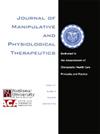对原发性痛经妇女进行结缔组织按摩与传统按摩的比较:随机临床试验
IF 1.4
4区 医学
Q4 HEALTH CARE SCIENCES & SERVICES
Journal of Manipulative and Physiological Therapeutics
Pub Date : 2023-06-01
DOI:10.1016/j.jmpt.2024.09.005
引用次数: 0
摘要
研究目的本研究旨在比较结缔组织按摩(CTM)和传统按摩(CM)对原发性痛经(PD)妇女的疼痛、功能和情绪状态以及月经不适的短期影响:方法:患有原发性痛经的妇女被随机分配到两组:方法:患有原发性痛经的妇女被随机分配到两组:CTM 组(19 人)和 CM 组(19 人)。从预计排卵日到下次月经来潮,每周使用 CTM 或 CM 5 天。在使用前后,使用视觉模拟量表评估疼痛强度,使用功能性和情绪性痛经量表(FEDS)评估功能性和情绪性痛经状况。同时还记录了疼痛持续时间和是否有月经不适:干预后,两组患者的痛经强度和持续时间、药物使用量和 FEDS 评分均有所下降(P < .001)。CTM 组的疼痛持续时间和 FEDS 功能评分的下降幅度大于 CM 组(P < .05)。此外,在干预后,与干预前相比,CM 组中精神紧张的女性人数较少,而 CTM 组中腰背痛、便秘和失眠的发生率较低(P < .05)。只有在干预前后失眠的变化方面,组间存在差异(P = .016):结论:CTM 和 CM 改善了痛经、功能和情绪状况,并减少了药物使用。此外,与中医治疗相比,CTM 在改善疼痛持续时间、功能状态和失眠方面更胜一筹。CTM和CM可能是治疗帕金森病的有效方法。本文章由计算机程序翻译,如有差异,请以英文原文为准。
Comparison of Connective Tissue Massage and Classic Massage in Women With Primary Dysmenorrhea: A Randomized Clinical Trial
Objective
The purpose of this study was to compare the short-term effects of connective tissue massage (CTM) and classic massage (CM) on pain, functional and emotional status, and menstrual complaints in women with primary dysmenorrhea (PD).
Methods
Women with PD were randomly assigned to 2 groups: CTM (n = 19) and CM (n = 19). CTM or CM was applied 5 days a week from the estimated date of ovulation to the onset of the next menstruation. The pain intensity with the Visual Analog Scale and functional and emotional status with the Functional and Emotional Dysmenorrhea Scale (FEDS) were assessed before and after the applications. Pain duration and the presence of menstrual complaints were recorded.
Results
In the postintervention period, both groups had decreased menstrual pain intensity and duration, drug use, and FEDS scores (P < .001). Pain duration and FEDS-functional scores decreased more in the CTM group than in the CM group (P < .05). Moreover, in the postintervention period, fewer women were nervous in the CM group, whereas low back pain, constipation, and sleeplessness were less frequent in the CTM group, compared with their preintervention period (P < .05). A difference was observed between groups only in terms of the changes in sleeplessness between before and after intervention (P = .016).
Conclusion
CTM and CM improved menstrual pain and functional and emotional status, and decreased drug use. Moreover, CTM was superior in improving pain duration, functional status, and sleeplessness compared with CM in PD. CTM and CM might be useful treatment methods for PD.
求助全文
通过发布文献求助,成功后即可免费获取论文全文。
去求助
来源期刊
CiteScore
3.00
自引率
7.70%
发文量
63
审稿时长
29 weeks
期刊介绍:
The Journal of Manipulative and Physiological Therapeutics (JMPT) is an international and interdisciplinary journal dedicated to the advancement of conservative health care principles and practices. The JMPT is the premier biomedical publication in the chiropractic profession and publishes peer reviewed, research articles and the Journal''s editorial board includes leading researchers from around the world.
The Journal publishes original primary research and review articles of the highest quality in relevant topic areas. The JMPT addresses practitioners and researchers needs by adding to their clinical and basic science knowledge and by informing them about relevant issues that influence health care practices.

 求助内容:
求助内容: 应助结果提醒方式:
应助结果提醒方式:


